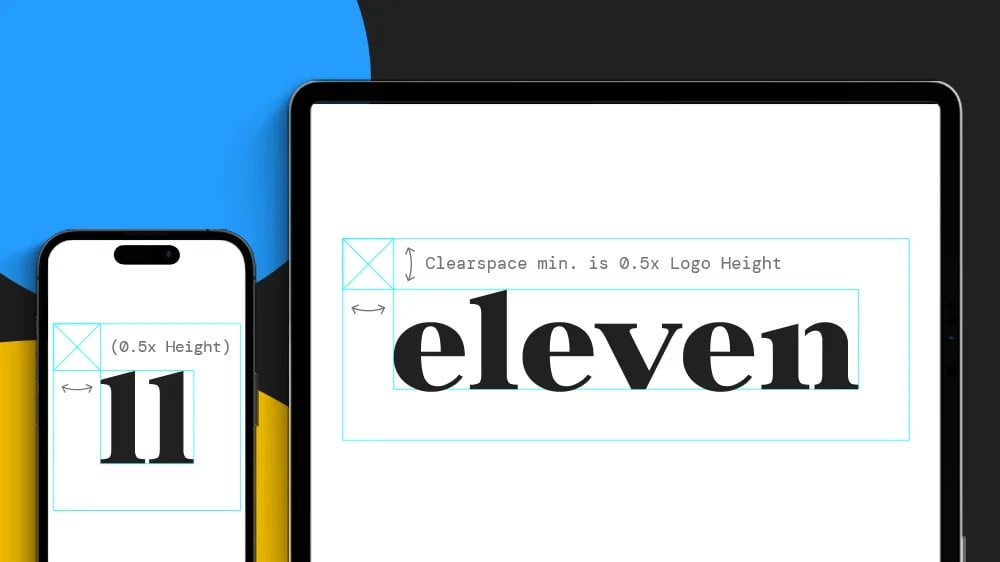Consistency across all touchpoints
When brand guidelines are reduced to just your logo, and how that logo is applied to static assets, so much of the bigger picture around the application of your brand is diluted. How your brand is applied across multiple channels – both on and offline – is something that needs to be captured if you want to achieve consistency and cohesion. This can involve everything from the difference between print and digital colour shades to which web-safe fonts are included in your brand typography.
Clarity around sizing, spacing and positioning
Responsive web design enables layouts to adjust automatically, based on the user’s device and screen size. This means creative teams need to consider how branding and visual elements scale across various breakpoints. You also need to have a clear understanding how your brand application differs across different content forms – for example, how many visual elements you include in a small digital banner ad will differ greatly from what you include in a brochure or eBook.
Integrating interactive content
Digital platforms offer unrivalled opportunities for brands to express themselves interactively. Whether that’s through animation, video or immersive digital experiences, including specific guidance on how your brand is applied to these innovative formats empowers your organisation to diversify your content offering and ensure that your brand is represented in the most engaging way possible.
Enhanced UX and accessibility
Ensuring that your organisation’s content is designed with accessibility in mind all starts with having comprehensive guidance on the accessible application of your brand in your guidelines. This includes considerations like responsive design for mobile devices, legible typography for readability and compatibility with assistive technologies (like screenreaders).
Alignment with tone of voice
Just as the visual application of your brand needs to be consistent across digital touchpoints, so does your brand’s tone of voice. Whether it’s for a social post or an email digest, every communication you share with the world should reflect your brand’s values. By including guidance on having an aligned tone of voice across all on and offline channels, you ensure that all the content you produce is written in a voice that resonates with your target audience and reinforces your brand’s positioning.
One step further: taking your brand guidelines online
With their interactive, linkable, up-to-date, and user-friendly nature, online brand guidelines offer a more inclusive and effective approach to promoting brand consistency throughout an entire organisation.
This is why we recently launched Unbound by Eleven – an end-to-end digital document solution for public and third sector organisations. Unlike traditional PDFs, Unbound uses interactive features to allow your internal and external stakeholders to access and use your brand guidelines in a way that suits them.
The benefits of opting for online brand guidelines using Unbound are almost endless, but here are some of our favourites…
Accessibility and availability: Digital brand guidelines are accessible to anyone with an internet connection, ensuring widespread availability to all your employees, external collaborators, and stakeholders globally.
Interactivity and engagement: By enabling users to actively participate rather than passively consume information, Unbound uses interactivity features which fosters increased engagement and comprehension of your guidelines. It also demonstrates how an animation or different sized posts should look. These features make it easy for people to search and navigate to particular sections for an efficient way to retrieve, share and reference information. It can also demonstrate how an animation or different sized posts will look in real time.
Collaboration and sharing: Digital guidelines streamline teamwork among both internal and external teams, guaranteeing alignment across all stakeholders. As they’re easily shareable and editable, they facilitate seamless feedback and discussion which fosters a cohesive working environment.
Downloadable assets: With digital guidelines, brand assets can be stored in the cloud and downloaded at the click of a button, meaning you don’t have to waste time searching on servers or through email threads.
Updating your brand guidelines for a digital age isn’t about just keeping up with the latest trends in digital marketing. It’s an essential strategic direction for organisations looking to champion and elevate their brand presence like never before.
If you’d like support with updating your brand guidelines to include clear guidance on digital application, we’d love to work with you – feel free to get in touch and we can walk you through the process.
For more information on how you can create online brand guidelines with Unbound by Eleven, click here
Originally published:
April 25, 2024
Updated:
April 29, 2024






